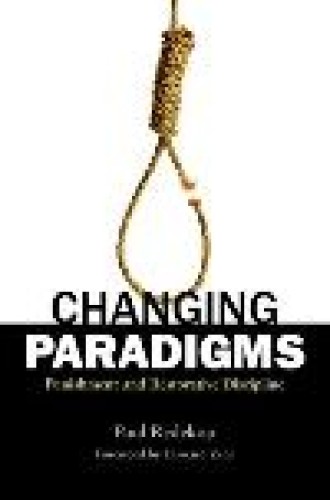Punitive measures
As an undergraduate student 25 years ago, I found myself behind bars—not as an inmate but as a correctional officer. One of the youngest members of a large metropolitan sheriff’s department on the west coast of Florida, I worked full-time at the maximum-security jail in order to pay for college. Those four years working in the slammer schooled me, and they raised a number of questions for me as a Christian, especially about the death penalty and the use of force. I am continuing to unlearn certain attitudes and assumptions I held then, including some about punishment itself.
By vividly putting into words much of what I have personally pondered about prisons and punishment, these two books should help American readers—Christian or not, possessing firsthand experience with incarceration or not—to step back and take an honest look at what is happening in our current practice of large-scale imprisonment. Each book also asks why we insist on continuing down this punitive path.
Why is it, for example, that the U.S., which has 6 percent of the world’s population, incarcerates 25 percent of the world’s prisoners? We currently have some 2.3 million persons in federal, state and local jails and prisons—an estimated half-million more than are locked up in China, whose population is more than triple that of the U.S. We spend more money building and maintaining prisons than public schools—to the tune of $50 billion a year. Some 644,000 persons are incarcerated per year and about 625,000 are released, but then 50 to 75 percent of those who are released end up returning to prison within a few years. No other democratic nation today imprisons people on such a scale or for as long as the U.S. Yet what are we accomplishing?
Both of these authors observe that re tributive punishment has become the primary engine driving large-scale im prisonment. James Samuel Logan, a Men nonite ethicist who teaches religion and African-American studies at Earl ham College, gives attention to the various ways punishment has been understood in theory and in practice, historically and today, focusing on how punishment in the U.S. system of imprisonment is especially demeaning to offenders. This approach to punishment boils down to chastising people to teach them their proper place. Paul Redekop, who teaches conflict resolution studies at Menno Simons College at the University of Winnipeg, also zeroes in on how retributive punishment is degrading to offenders. Unlike Logan, however, Redekop extends his analysis of punishment beyond criminal justice to other areas in which “teaching a lesson” is prominent: parenting, education and international relations.
The punitive approach to imprisonment not only has adverse effects on prisoners, it leads to results that are the reverse of what society expects. According to Logan, the prison-industrial complex, which is “rife with practices of violence and degradation,” reproduces criminality. Redekop writes that imprisonment creates a “criminal culture” that amplifies “the likelihood that people will commit crimes” and will be “therefore more likely to return to prison.” Especially disturbing in this connection is how common it is for inmates to be raped, or “punked out,” in jails and prisons that Logan refers to as “punk factories.” He quotes ex-offender David Lewis, president and cofounder of the California-based outreach program Free at Last, who says, “Prison is a school and violence is the curriculum.” This is particularly troubling given that 75 percent of new inmates are imprisoned for crimes that don’t involve violence.
Logan and Redekop also detail the effects of large-scale punitive imprisonment on prison staff, prisoners’ families and communities, and the wider society. In their view, this form of punishment has brutalizing effects and brings out the worst in people. Logan notes a number of times that jail and prison personnel are also “doing time,” albeit in eight-hour shifts, and that they bear the scars of imprisonment too. In the rest of society, Logan contends, retributive degradation exacerbates alienation, atomistic individualism, racism and an overall decline in “fellow feeling.”
Logan describes the effect of large-scale imprisonment on the African-American community. Black males make up less than 7 percent of the U.S. population, but they constitute approximately 37.5 percent of its jail and prison population. More than a half-million fall between the ages of 20 and 39; this devastates families and neighborhoods because in that age bracket lies human capital necessary for a community’s social, economic and political stability.
Black females now constitute the fastest-growing segment of the prison population. Most incarcerated women are mothers. Their imprisonment results in collateral emotional and psychological damage to around 1.5 million prison “orphans.” The retributive approach to criminal justice “ends up punishing the families of offenders by leaving them destitute,” Redekop writes.
Given that retributive punishment leads to all of these negative results, why do we continue to practice it? Part of the answer is that jails and prisons are now big business. In addition to for-profit correctional corporations, many other companies benefit from expanding imprisonment, including food-service companies, construction contractors, furniture manufacturers and the “specialty item” industry (makers of handcuffs, fencing and drug detectors). Major companies—Logan mentions Microsoft, Honda and Victoria’s Secret—employ cheap prison labor. Small rural communities used to object to plans to build prisons in their areas. Now they welcome prisons to boost their struggling economies.
Beyond such economic pressures, both Logan and Redekop think that the underlying problem is our captivation with the idea of retributive punishment. Punishment, says Redekop, is “a historical artifact passed from one generation to the next without much thought and supported by force of habit and by unexamined assumptions and presuppositions.” Logan asks why there is a presumption that criminal justice must issue in retributive punishment, and Redekop queries why there is a presumption that we should punish at all. Whereas Logan offers a theology of “good punishment,” Redekop believes we should “remove punishment from our repertoire of responses to conflict” altogether.
Drawing on Stanley Hauerwas’s work in Christian ethics, including a recent essay called “Punishing Christians,” Logan calls on the church to imagine and model a better response to crime and to help the rest of society construct one. Hauerwas’s account of Christian punishment—which includes excommunication, penance, reconciliation and forgiveness—offers a “politics of healing memories” that Logan considers promising for the formulation of an alternative to punitive, large-scale imprisonment.
To Hauerwas’s contribution Logan appends a “politics of ontological intimacy,” whereby human interrelatedness amidst diversity encourages us to signal to an offender: “We care about you, you are still one of us, even as we must now insist that you take serious responsibility for your offense.” Instead of confronting, Logan advocates “care-fronting.” The final chapter of his book identifies some places where there is evidence of such a politics—in restorative justice programs, calls for “decarceration” and efforts to decriminalize nonviolent acts such as drug use, welfare fraud and prostitution.
Drawing on the work of Howard Zehr in restorative justice, Redekop calls for an approach that enables offenders to be active participants in making things right for all stakeholders—victims, offenders, the community and society as a whole. Citing examples from Northern Ireland, New Zealand and Canada, he presents an alternative paradigm for all situations in which punishment has been assumed to be both necessary and morally legitimate, from parenthood to the aftermath of armed conflict. Two mottoes held in tandem summarize this restorative approach to justice: “No more victims” and “No one is disposable.”
Both authors allow for the confinement of dangerous inmates, though in places much smaller and more humanizing than current prisons. They could have devoted more imagination to this sad necessity. Shortly before his death, John Howard Yoder shared with me an unpublished working paper on providing “a life for lifers” in secure communities modeled after the cities of sanctuary in the Hebrew scriptures. What if churches undertook such a project, just as in the past they built and operated schools and hospitals?
Despite this shortcoming, Logan and Redekop’s efforts will help us to rethink punishment and create new ways to deal with perpetrators as persons.







